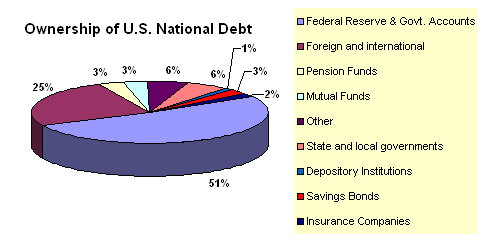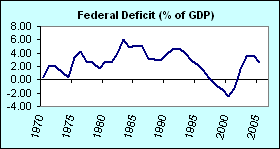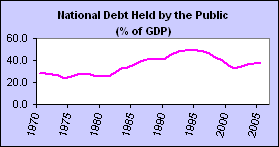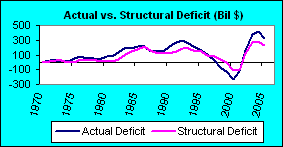The budget deficit is the amount by which the federal government's outlays exceed its revenue in a given year. The national debt is the federal government's total indebtedness at a moment in time.
|
|
Note: Large images are available for viewing by clicking on the smaller images on this page.
A budget deficit is the amount by which the federal government's outlays exceed its revenue in a given year. If, for example, the government collects $700 in tax revenue in the year but spends $900, the budget deficit is $200. (Correspondingly, the budget surplus is -$200.) The national debt is the federal government's total indebtedness at a moment in time. It results primarily from previous deficits.
The difference between the budget deficit and the national debt is the difference between a flow (something measured over a period of time) and a stock (something measured at a point in time). A good analogy is to think of water filling into a swim pool. The rate at which the water is pouring out of the spicket filling up the pool is comparable with the budget deficit. The total amount of water in the pool at any point in time is comparable with the national debt. Deficits accumulate over a period of time (we typically describe deficits on a yearly basis) but the debt can be measured at any given second. Note that if the spicket pours water into the pool at a faster rate, the level of water in the pool rises more quickly.
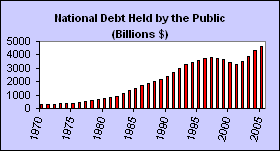
Just how much debt does the U.S. government have? As of August, 2006, the total national debt was $8.4 trillion. This amounts to $28,000 for each of the approximately 300 million persons living in the U.S. The U.S. Treasury Department maintains statistics on the Debt to the Penny. As we discuss below, much of the debt is held by the government itself; the debt held by the public--shown in the figure titled National Debt Held by the Public--was $4.6 trillion at year-end 2005.
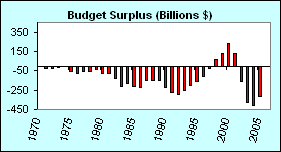
Budget deficits increased significantly in the mid-1980s and peaked in the early 1990s, as illustrated in the figure titled Budget Surplus. Economists blame several factors for the increased deficits of the 1980s. First, outlays for government entitlement programs, especially Social Security and Medicare, surged in the 1980s. Second, the productivity growth rate of the economy slowed somewhat inexplicably after 1973 (see Chapter 18, Economic Growth and Productivity), reducing the growth of the nation's tax base. Third, President Reagan simultaneously passed tax cuts and increased significantly expenditures for defense. Congress rejected most of the planned non-defense budget cuts that Reagan proposed. The combination of higher spending and lower tax revenues led to higher budget deficits. The deficits of the early 1990s were compounded by the recession of 1990-91. Not until 1993 did deficits begin to shrink. Because of the strong U.S. economy in the latter half of the 1990s, budget deficits shrunk rapidly. In fact, the U.S. ran surpluses between 1998 and 2001. The surplus topped $236 billion in 2000 and $128 billion in 2001. In 2002 the more typical deficit pattern emerged again. The $378 billion deficit in 2003 and the $413 billion deficit in 2004 are partly due to the recession in 2001, the stock market decline, tax cuts enacted under President Bush, and increased government spending to combat terrorism and invade Iraq. The 2004 budget deficit of $413 billion is in nominal terms the largest deficit in U.S. history, although as we explain below, deficits relative to the size of U.S. income were larger in the 1980s.
|



